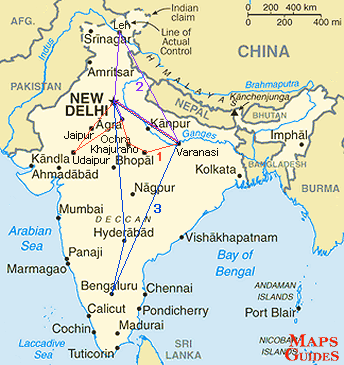India (Hindi: भारत Bhārat; see also other Indian languages), officially the Republic of India (Hindi: भारत गणराज्य Bhārat Gaṇarājya), is a country in South Asia. It is the seventh largest country by geographical area, the second most populous country and the most populous democracy in the world. Bounded by the Indian Ocean on the south, the Arabian Sea on the west, and the Bay of Bengal on the east, India has a coastline of 7,517 kilometers (4,671 mi). It borders Pakistan to the west; China, Nepal, and Bhutan to the north-east; and Bangladesh and Burma to the east. India is in the vicinity of Sri Lanka, the Maldives, and Indonesia in the Indian Ocean. Home to the Indus Valley Civilization and a region of historic trade routes and vast empires, the Indian subcontinent was identified with its commercial and cultural wealth for much of its long history. Four major world religions, Hinduism, Buddhism, Jainism and Sikhism originated here, while Zoroastrianism, Judaism, Christianity and Islam arrived in the first millennium CE and shaped the region's diverse culture. Gradually annexed by the British East India Company from the early eighteenth century and colonised by the United Kingdom from the mid-nineteenth century, India became a modern nation state in 1947 after a struggle for independence that was marked by widespread nonviolent resistance. India has the world's twelfth largest economy at market exchange rates and the fourth largest in purchasing power. Economic reforms have transformed it into the second fastest growing large economy; however, it still suffers from high levels of poverty, illiteracy, and malnutrition. A pluralistic, multilingual, and multiethnic society, India is also home to a diversity of wildlife in a variety of protected habitats.
WikipediaAryan tribes from the northwest infiltrated onto the Indian subcontinent about 1500 B.C.; their merger with the earlier Dravidian inhabitants created the classical Indian culture. The Maurya Empire of the 4th and 3rd centuries B.C. - which reached its zenith under ASHOKA - united much of South Asia. The Golden Age ushered in by the Gupta dynasty (4th to 6th centuries A.D.) saw a flowering of Indian science, art, and culture. Arab incursions starting in the 8th century and Turkic in the 12th were followed by those of European traders, beginning in the late 15th century. By the 19th century, Britain had assumed political control of virtually all Indian lands. Indian armed forces in the British army played a vital role in both World Wars. Nonviolent resistance to British colonialism led by Mohandas GANDHI and Jawaharlal NEHRU brought independence in 1947. The subcontinent was divided into the secular state of India and the smaller Muslim state of Pakistan. A third war between the two countries in 1971 resulted in East Pakistan becoming the separate nation of Bangladesh. India's nuclear weapons testing in 1998 caused Pakistan to conduct its own tests that same year. The dispute between the countries over the state of Kashmir is ongoing, but discussions and confidence-building measures have led to decreased tensions since 2002. Despite impressive gains in economic investment and output, India faces pressing problems such as significant overpopulation, environmental degradation, extensive poverty, and ethnic and religious strife.
CIA The World Factbook 




